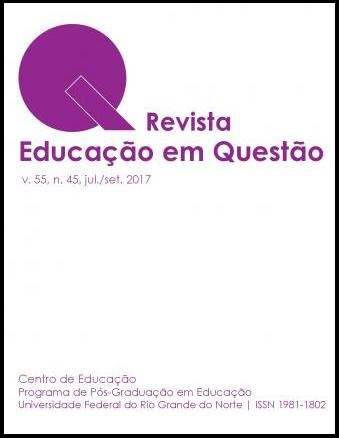The method Life Kinetik® from the point of view of neuroscience and education
a theoretical analysis
DOI:
https://doi.org/10.21680/1981-1802.2017v55n45ID12748Keywords:
Learning. Life Kinetik. Neuroplasticity.Abstract
Methods that combine motor activities with cognitive activities under the princi- ple of constantly challenging the brain with new combinations of activities, permanently increasing their degree of difficulty, but without requiring a mastery in the execution, are promising for the teaching and learning process. An example is the Life Kinetik method, developed by Lutz (2014). In the present study, the objective was to analyze, based on the neuroscientific literature, whether the processes that occur in the brain, attributed to the learning phenomenon, could be stimulated by this method. The results of this study show that neuroscience research reveals that brain plasticity processes that mediate learning processes are potentialized through activities that include three key factors: challenge, variety and non-perfection, which are considered essential methodology of Life Kinetik. Finally, due to easy application and its potential to optimize teaching-learning processes, is recommend an empirical evaluation of this method, especially in school environments.
Downloads
References
BRASIL. Lei nº 13.005, de 25 de junho de 2014. Aprova o Plano Nacional de Educação - PNE e dá outras providências. Diário Oficial da República Federativa Brasília, DF, 26 jun. 2014.
CARLSON, Neil. R. Physiology of Behavior.11. ed. Boston: Pearson, 2012.
CATANIA, Anthony. Aprendizagem: comportamento, linguagem e cognição. Porto Alegre: Artmed, 1999.
GRÜNKE, Matthias. Die Effekte des Life Kinetik®: Trainings auf die Aufmerksamkeits und die fluideIntelligenzleistung von Kindern mit gravierenden Lernproblemen. Heilpädagogische Forschung, v. 37, p. 2-12, mar. 2011.
JACOBSON, Roni. The persistence of memory. Scientific American, New York, v. 312, n. 4, p. 14-16, ago. 2015.
KAISER, Arnim; KAISER, Ruth. Studienbuch Pädagogik: Grund-und Prüfungswissen. 7. ed. Frankfurt am Main: CornelsenScriptor, 1994.
KANDEL, Eric, SCHWARTZ, James; JESSELL (Org.). Principles of neural science. 5 .ed. New York: McGraw-Hill Education/Medical, 2012.
KOSKI, Lisa; WOHLSCHLÄGER, Afra; BEKKERING, Harold; WOODS, Roger; DUBEAU, Louis; MAZZIOTTA, John; IACOBONI, Marco. Modulation of motor and premotor activity during imitation of target-directed actions. Cerebral Cortex, Oxford, v. 12, n. 8, p. 847-855, ago. 2002.
LIFE KINETIK. Coordenação de Horst Lutz, Josef Bauer e Maria Schweyer. Desenvolvido por Cinderella GmbH, Ebenhausen. Apresenta links sobre o Life Kinetik. Disponível em:<http://www.lifekinetik.de>. Acesso em: 5 mar. 2017.
LUTZ, Horst. Zusammenfassung der wissenschaftlichen Referenzen. LIFE KINETIK, Site coor- denado por Horst Lutz, Josef Bauer e Maria Schweyer e desenvolvido por Cinderella GmbH, Ebenhausen; online. Disponivel em: <http://www.lifekinetik.de/infos/wissenschaftliche-zusammenfassung/>. Acesso em: 5 mar. 2017.
LUTZ, Horst. Life Kinetik®: Gehirntraining durch Bewegung. 4 ed. München: blv Buchverlag, 2014.
LUTZ, Horst; NEUREUTHER, Felix. Mein Training mit Life Kinetik®. 3. ed. München: Nympfenburger, 2013.
MATTFELD, Aaron; STARK, Craig. Functional contributions and interactions between the human hippocampus and subregions of the striatum during arbitrary associative learning and memory. Hippocampus, Boston, v. 25, n. 8, p. 900-911, ago. 2015.
MAYES, Andrew; ROBERTS, Neil. Theories of episodic memory. Philosophical transactions of the Royal Society of London, London, v. 356, n. 1413, p. 1395-1408, set. 2001. (Series B: Biological Sciences).
ORGANIZATION FOR ECONOMIC CO-OPERATION AND DEVELOPMENT (OCDE). Country note Brazil: Programme of International Student Assessment (PISA): Results from PISA 2012. Disponível em:<http://download.inep.gov.br/acoes_internacionais/pisa/resultados/2013/country_note_brazil_pisa_2012.pdf> Acesso em: 2 mar. 2017.
ORGANIZATION FOR ECONOMIC CO-OPERATION AND DEVELOPMENT (OCDE.). Understanding the brain: The birth of a new learning science. OCDE. 2007. Disponível em: <http://www.oecd.org/edu/ceri/understandingthebrainthebirthofalearningscience. htm#B1>. Acesso em: 2 mar. 2017.
PEREIRA, Ana; HUDDLESTON, Dan; BRICKMAN, Adam; SOSUNOV, Alexander; HEN, Rene; MCKHANN, Guy; SLOAN, Richard; GAGE, Fred; BROWN, Truman; SMALL, Scott. An in vivo correlate of exercise-induced neurogenesis in the adult dentate gyrus. Proceedings of the National Academy of Sciences, Washington, v. 104, n. 13, p. 5638-5643, mar. 2007.
RAMACHANDRAN, Vilayanur. O que o cérebro tem para contar: desvendando os mistérios da natureza humana. Rio de Janeiro: Zahar, 2014.
ROTH, Muriel; DECETY, Jean; BACIU, Monica; MASSARELLI, Raphael; DELON-MARTIN, Chantal; SEGEBARTH, Christoph; MORAND, Stephanie; GEMIGNANI, Angelo; DÉCORPS, Michel; JEANNEROD, Marc. Possible involvement of primary motor cortex in mentally simula- ted movement: A functional magnetic resonance imaging study. Neuroreport, London, v. 7, n. 7, p. 1280-1284, maio 1996.
SIMPSON, Joy; KELLY, John. The impact of environmental enrichment in laboratory rats-beha- vioural and neurochemical aspects. Behavioural Brain Research, New York, v. 222, p. 246-264, set. 2011.
THOMPSON, Richard. The neural basis of basic associative learning of discrete behavioral responses. Trends in Neurosciences, New York, v. 11, n. 4, p. 152-155, abr. 1988.
UNGERLEIDER, Leslie; DOYON, Julien; KARNI, Avi. Imaging Brain Plasticity during Motor Skill Learning. Neurobiology of Learning and Memory, New York, v. 78, n. 3, p. 553-564, nov. 2002.
URSIN, Holger. Brain sensitization to external and internal stimuli. Psychoneuroendocrinology, New York, v. 42, p. 134-145, abr. 2014.
VAN PRAAG, Henriette; CHRISTIE, Brian; SEJNOWSKI, Terrence; GAGE, Fred. Running enhances neurogenesis, learning, and long-term potentiation in mice. Proceedings of the National Academy of Sciences, v. 96, n. 23, p. 13427-13431, set. 1999.
VAN PRAAG, Henriette; SHUBERT, Tiffany; ZHAO, Chunmei; GAGE, Fred. Exercise enhan- ces learning and hippocampal neurogenesis in aged mice. The Journal of Neuroscience, v. 25, n. 38, p. 8680-8685, set. 2005.
Downloads
Published
How to Cite
Issue
Section
License
The Journal Education in Question shall retain the copyright in all articles that it publishes.
The authors and co-authors of articles and book reviews, published in the Journal Education in Question, shall wait for at least 1 (one) year before they are allowed to submit new works for publication.






